
Aachen Cathedral is a Roman Catholic church in Aachen, Germany and the see of the Roman Catholic Diocese of Aachen.

A Bismarck tower is a specific type of monument built according to a more or less standard model across Germany to honour its first chancellor, Otto von Bismarck. A total of 234 of these towers were inventoried by Kloss and Seele in 2007 but more have been discovered since making the total around 240. These towers were built between 1869 and 1934 and some 173 remain today. Quite a few of these towers, including all 47 based on Wilhelm Kreis's Götterdämmerung design, were built as so-called Bismarck Columns (Bismarcksäulen) or were converted into them. This description goes back to the Student Union's competition held in 1899, which was to encourage the erection of as many beacons as possible. But other Bismarck towers, e.g., those that were purely beacons with no observation function, were often called Bismarck columns.

The Golden Madonna of Essen is a sculpture of the Virgin Mary and the infant Jesus. It is a wooden core covered with sheets of thin gold leaf. The piece is part of the treasury of Essen Cathedral, formerly the church of Essen Abbey, in North Rhine-Westphalia, Germany, and is kept on display at the cathedral.

Kallstadt is a village in the Palatine part of Rhineland-Palatinate, one of Germany's 16 federal states. It is part of the Rhine-Neckar Metropolitan Region whose largest city is Mannheim, Germany's 22nd largest city. During much of the 19th century, it was part of the Kingdom of Bavaria. It has gained international media attention as the ancestral home of the related Heinz and Trump families, two prominent business and political families in the United States.

The Russian Orthodox Church of Saint Elizabeth in Wiesbaden is the only Russian Orthodox church in Wiesbaden, Germany, and is located on Neroberg. Besides the Russian church there is a parsonage and a Russian cemetery, which is the largest in Europe. St. Elizabeth's Church and its parishioners belong to the Diocese of Germany in the Russian Orthodox Church Outside Russia.
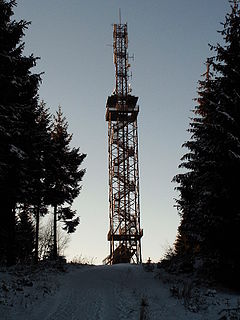
The Carlshaushöhe is a mountain, 626.3 m, in the Harz in the German state of Saxony-Anhalt.
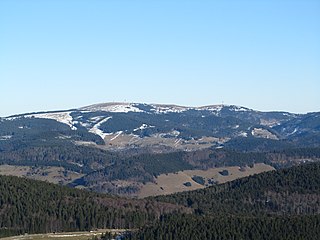
At a height of 1,448.2 m above sea level (NHN) the Seebuck is the second highest mountain the Black Forest after the Feldberg It is located in the German state of Baden-Württemberg.

The Lessing Theater was a theatre in the Mitte district of Berlin, Germany. It opened in 1888 and was destroyed in April 1945 in a bombing raid; its ruins were demolished after World War II.

The Bismarck Tower located in Viersen was erected in honour of the chancellor Otto von Bismarck and has since become an icon of the city of Viersen.

From 1868 onwards, Bismarck monuments were erected in many parts of the German Empire in honour of the long-serving Prussian minister-president and first German Reichskanzler, Prince Otto von Bismarck. Today some of these monuments are on the soil of other countries including France, Poland and Russia as well as the former German colonies on other continents.
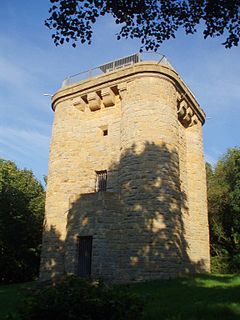
The Bismarck Tower on the 268-metre (879 ft) high Stahlsberg above Opperode in Germany is a monument to the former German chancellor, Bismarck. The tower can be used as an observation tower. It was built in 1914/15.

Granitz Hunting Lodge is located on the German island of Rügen in the vicinity of the seaside resort of Binz. With over 200,000 visitors per year it is the most popular castle or schloss in Mecklenburg-Vorpommern.
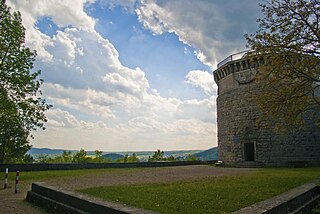
The construction of the Bismarck Tower located on the "Sinnberg", a hill in the German spa town of Bad Kissingen, started in 1914 following the plans designed by architect, Wilhelm Kreis. It was projected by the local Bismarck Tower Association under the chairmanship of its founder, pharmacist Oscar Ihl. This association was in favour of Bismarck and the German Empire and competed in a certain way with the Wittelsbacher Association, which, even after the Unification of Germany, regarded the Kingdom of Bavaria to be a sovereign kingdom and built the Wittelsbacher Tower in Bad Kissingen in 1907.

Georg Wrba was a German sculptor and graphic artist. He created some 3,000–4,000 works, including as a collaborator of the Zwinger workshop.

The Frankenberg Castle is a castle in the Frankenberg area of Aachen-Mitte, itself a district of Aachen, Germany. Its name comes from the concept of a “Franke”, which was a type of castle that did not owe fealty to any others. Of course, shortly after its construction, the lowland castle became a fief of a Graf, and later belonged to the Duchy of Jülich-Cleves-Berg.

The Bismarck Tower on the 497-metre-high Peterskopf in the Haardt mountains on the eastern edge of the Palatine Forest stands within an exclave of the municipality of Kallstadt in the German state of Rhineland-Palatinate.

The Franziskaner-Klosterkirche was a church in the Mitte district of Berlin, founded in 1250 and now in ruins.
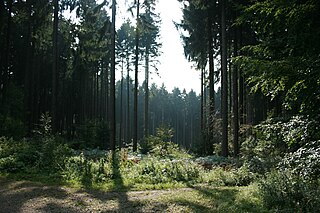
Aachen Forest lies about 3.7 km south of the city centre of Aachen and has an area of 2,357 ha. It essentially comprises the forest areas of the former free imperial city of Aachen south and west of the formerly independent municipalities of Burtscheid and Forst, as well as north and east of the Belgian border. Apart from a few small plots, it is all in municipal ownership. In July 2003, the Forest of Aachen was awarded the environmental seal of the Forest Stewardship Council (FSC) on the initiative of Greenpeace, which was extended in 2008 for another five years.

The Bismarckturm is a 28 metre high Bismarck monument. It is located on the Schlossberg north of Burg (Spreewald).
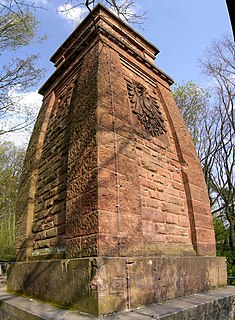
The Bismarck tower in Freiburg im Breisgau belongs to a series of towers that were built in honor of Otto von Bismarck, the first German chancellor. It is located on the Schlossberg. It is 12.6 m (41 ft) tall and has a square base. The top of the tower can only be reached by climbing a ladder. Because of this it can not be used as an oberservation deck.





















